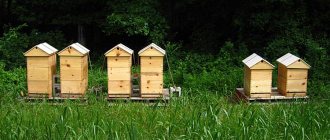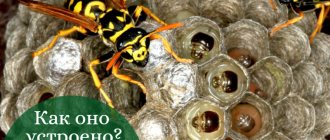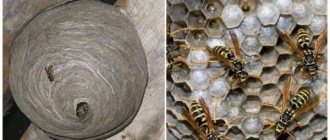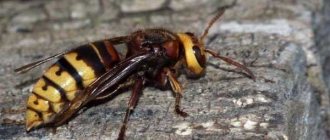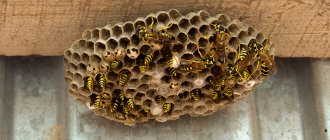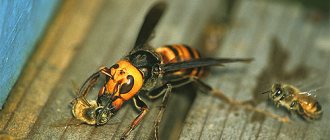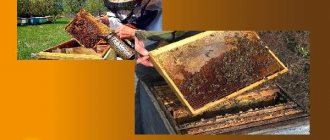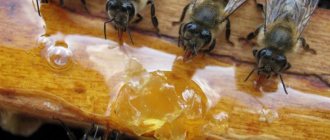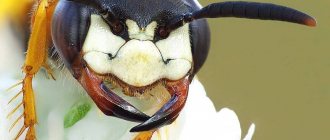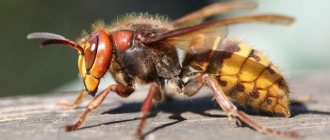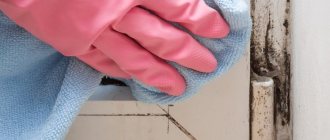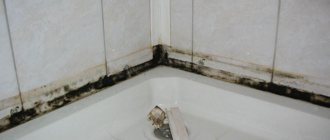- Blog articles
- Beekeeping
Beekeeping
Economics of beekeeping
Beekeeping news in Russia
Beekeeping news in the world
Honey
Propolis
Bee bread
Zabrus
Royal jelly
In the world about bees
Apiary
Bees
News from honey fairs
From the history of beekeeping
- Wasps? Let's get to know each other better
- Why are wasps dangerous in the apiary?
- Hornets are the mighty enemies of bees.
- How to get rid of wasps in an apiary. Methods and methods of struggle
- We fight wasps with traps
Wasps? Let's get to know them better
These amazing insects have been familiar to us since childhood. Most normal people feel fear and disgust when they see them. Part of humanity has heard about the painful bites of Hymenoptera and is fighting wasps with all their might. Some are “lucky” to experience this pleasure for themselves. Striped, rather graceful representatives of the family have many close relatives: bees, ants, bumblebees, ichneumon riders, sawflies. Fun fact: scientists tend to believe that bees and ants are the ancestors of one of the ancient species of wasps. Long evolution has taught them to feed exclusively on flower nectar. Reputable scientists explain the appearance of ants as follows: they lost their wings during their development. Australian bulldog ants have a stinger and potent venom to support this theory.
Among the individuals we are considering, there are many loners. There are even more inhabitants living in groups. We are interested in those that constantly interfere with honey collectors. First of all, they are enemies of the apiary and beekeeping in general. As a rule, they also love to collect sweet treats. Therefore, they are often seen on large receptacles. There is an opinion: they consume the meat (so to speak) of our favorites. Is it so? Biologists say that they need someone else’s flesh not for their own nutrition, but for feeding their offspring. The larvae are, indeed, unusually gluttonous and require a “meat” diet.
Methods of disposal
The methods listed below will tell you how to deal with annoying neighbor bees.
Before going to extreme measures, be sure to make sure that you have done everything necessary:
- If your neighbors have bees that sting and you don't know what to do, talk to the owner.
- Get rid of bees on your property using folk remedies.
- Use of insect repellents.
What to do, how to act if your neighbor has honey miners who don’t give him peace? Of course, the use of insect repellents. To understand how to protect yourself from your neighbor’s aggressive insects by using repellers, study the principle of operation:
- Lamps. They attract neighboring insects using ultraviolet light and shock them.
- Ultrasonic devices. The waves they emit scare away and kill uninvited guests.
- Special lamps. Covers an area of 30-45 meters. They have a long period of use - 4-5 years.
- Poison. Set up some traps. Pour a sweet liquid into it, add salt and toxic substances. If you do not want to come into contact with poison, contact the sanitary and epidemiological station. Disinsection service employees will quickly destroy the annoying inhabitants of the apiary.
How to destroy dangerous bees? Use traps, drinking bowls, which you fill with sweet bait - compote, jelly, juice. Add toxic substances and salt to the liquid.
Traditional methods of disposal
There are several options for using folk remedies to combat hive inhabitants.
Method 1: Using traps. To figure out how to destroy dangerous bees with traps, you need to learn how to make them. Prepare insect traps from plastic bottles. Pour a sweet liquid into the container - syrup, compote, which will attract honey miners. They will not be able to get out of the trap.
Method 2. Find unnecessary rags. Moisten it with a solution of essential oils, peppermint decoction, and vinegar solution (10-15 ml of vinegar are diluted with 1.5-2 liters of water). Hang the rags on the dividing fence of the areas.
Method 3: Build a fire. The smell of smoke scares away the inhabitants of the hives. Throw dry catnip branches into the fire. Light a fire away from trees and wooden buildings.
Method 4: Play a recording of bird sounds. Download a recording of birdsong from the Internet. Play as often as possible.
Method 5: Hang bags filled with mothballs to protect the area.
Video: Fighting wasps in the apiary
In everyday life, ordinary people observe paper wasps. They love to steal some of the sweet product on occasion. They calmly climb into an open hive during inspection. They take tribute impudently and shamelessly. Defender bees do not always attempt to protect a home. They are weaker physically. Nevertheless, attempts to resist and fight are made regularly.
Method one - spring
The fight against wasps should begin in early spring, when the first flight of bees occurs. Wasps also fly at this time, and more actively. They are not so afraid of temperature changes and can completely freely go on “cruises” when your charges from the hive do not even show their noses.
In your yard, examine all the secluded corners where wasps can nest. These are attics, basements, cracks in the walls of buildings, trees, hollows. If you notice a nest, destroy it immediately, and do not forget about the larvae. These are such “infections” that they can breed even outside the nest.
The next step is to go around the neighbors. Surely they won’t mind if you help them get rid of the dangerous neighborhood of striped creatures. Practice proves the effectiveness of this method. But he cannot give a 100% guarantee of safety. Therefore, you need to be vigilant!
Why are wasps dangerous in the apiary?
Constant raids on the apiary farm ultimately end in the same way: she grabs the victim that turns up and goes home! If this were the only reason for hostility towards them, it wouldn’t be so bad. Even with a massive attack, with tangible damage, the negative is less compared to a hidden threat. The sad thing is that predators (this nickname has stuck tightly to them) have invasive diseases similar to the bee breed. With careful care there is no guarantee of basic safety. There is only one conclusion: declare a merciless war on the wasps. It is clear that we will not defeat everyone, but it is necessary to strive for the goal and fight.
Discussing the problem with neighbors and finding a joint solution
Unfortunately, most novice beekeepers do not realize that placing an apiary requires installing high three-meter fences around the territory.
This allows insects to gain altitude in flight and, bypassing neighboring areas, go towards flowering fields. This is why it is important to discuss the problem of nuisance bees with your neighbor and try to reach a compromise. To make the conversation more convincing, you should warn that if the problem is not solved, then bait will be placed around the area
In most cases, such an argument allows you to quickly solve the problem.
Discuss the problem with your neighbors
Hornets are the mighty enemies of bees.
It is generally accepted that you need to know your enemy by sight. We have already met some of them. Hornets also cause trouble. They are larger and have impressive dimensions. Externally, they have a characteristic wide nape and dark red spots on the head. By the way, this enlarged creature has a rather peaceful disposition. His attacks on our fellow tribesmen are much less frequent.
The described “cuties” have powerful jaws. So strong that they rarely use their main trump card, but crush the chitinous cover of the victim in a matter of seconds. By the way, they have their own natural enemies: blackflies and dragonflies, and golden bee-eaters. While we scare away pest birds, we save dragonflies to fight hornets.
Wasp victories are determined by the following factors:
- They have two weapons for battle.
- The body structure is more flexible, elastic, and mobile.
- The sting does not have serrations, so it can sting several times.
- Its poison is more dangerous and is administered in larger quantities.
Preventive measures
Experienced beekeepers know that the best way to protect a hive from any misfortune is a strong bee colony. She needs to be provided with a complete food supply and good living conditions. The family must have a young, highly productive queen. She gives more offspring. The hives should be insulated so that the bees do not have to waste energy heating the brood.
A strong family is able to cope with the invaders on its own. She can even repel an attack from hornets. The dimensions of the European hornet are 22-25 mm, they are not much larger than honey insects. In countries where aggressors reach 50-70 mm, local bees have developed special battle tactics. They surround the hornet in a dense ball of several hundred individuals. Thanks to the movement of the bodies and the vibration of the wings, the temperature inside the swarm rises to 470. The heat quickly kills the predator. After two or three minutes, the bees fly away and the hornet falls dead.
How to get rid of wasps in an apiary. Methods and methods of struggle
Whatever one may say, wasps are especially dangerous. At every opportunity, fight them and take advantage of every opportunity to destroy them. The accumulated experience indicates the sufficient effectiveness of many generally accepted methods of control.
The simplest solution to fight is to find and eliminate nests. They prefer places in attics, under awnings, in the space between roof sheathing and slate. In a word, adherents of secluded hiding places. If you tear down their construction and throw it into a bucket of water, consider it a good deed. Or burn it. After all, even adults and children are afraid of them. It's easy to say. Difficult to accomplish. Let's look at the procedure step by step. We remember the location. We carry out the operation in the dark, when the enemy is assembled but inactive. Carefully stretch the spacious plastic bag and pull the ball out of place. (It is supported by one single mounting leg). We tie it quickly and tightly. Next - a water procedure or an acquaintance with the properties of fire...
Safety precautions when destroying wasp nests
Wasps, as a rule, fight for their house to the last, and the whole flock attacks the one who dares to disturb their peace. Therefore, before you start fighting them, you need to protect your body and face with appropriate equipment. You can use a special beekeeper suit - it will reliably protect against stings. But if it is not there, a suitable alternative would be:
- high boots made of rubber;
- cotton pants and a thick jacket;
- gloves made of rough fabric;
- wide-brimmed hat;
- a net worn over the head over a hat.
Care must be taken to ensure that all parts of the body are completely covered with clothing. If wasps manage to get to, for example, an unprotected neck, ankles or arms, the consequences can be dire!
Preparatory work before cleaning
In order to avoid critical situations, before getting rid of a wasp’s nest, you need to show foresight and do something in advance:
- choose the right time for stripping (it is better to do this at night or before dawn, when the insects are hibernating);
- prepare all the necessary means and tools to destroy the nest, so as not to waste time searching for them later;
- think about escape routes in case a whole flock of wasps attacks (you can, for example, quickly run to the car, jump in and slam the door);
- discuss with household members where they will hide at a time when angry insects fly around the area and look for someone to attack;
- close all doors and windows in the house so that wasps cannot enter;
- wear a respirator (if you have to deal with toxic substances).
The most suitable time of year for the procedure of getting rid of wasps is spring. During this period, wasp nests have not yet been completed, and there are still relatively few adult individuals in them.
Possible consequences of contact with insects
The consequences of their bites depend on two factors: how many times wasps have bitten a person, and whether he is allergic to wasp venom.
With a normal reaction of the body, everything will be limited to the following symptoms:
- sharp burning pain in the bite area;
- pronounced redness around the wound;
- a small swelling that grows quickly and then gradually subsides;
- itching (it goes away more slowly than pain).
As a rule, all of the above manifestations disappear relatively quickly. The pain disappears after about 2 hours, the swelling completely subsides on the second day. But if an allergic reaction develops, the symptoms will be much more serious. The victim experiences:
- severe swelling in the bite area;
- hives (small itchy rash on the body);
- a sharp increase in temperature;
- tachycardia;
- dyspnea;
- headache;
- lowering blood pressure;
- nausea, sometimes vomiting;
- Quincke's edema and anaphylactic shock (in case of multiple bites).
The stronger the allergy, the faster the reaction to wasp venom entering the body develops. To prevent death, the victim must urgently be given an antihistamine and call an ambulance.
Even for a healthy person, it is extremely dangerous when wasps bite on the neck or head (especially the tongue). This is fraught with swelling of the larynx with the development of suffocation.
Video: How to properly deal with wasps in an apiary
More than once I came across situations when, not far from the point, I noticed wasps flying out of the underground shelters of “thieves of state property.” To be honest, for the first time I was stunned upon closer acquaintance. Believing that there were several creatures there, at most a dozen, I decided to accustom them to substance abuse. I took a can of Dichlorvos and at the same time grabbed an empty can of oil paint.
He carried out the execution in the evening twilight, judging sensibly that at this time the “sworn friends” would gather for the night. There was no limit to surprise when I let in a long stream of aerosol, then prudently covered the round hole with a can, pressing it down with my foot to be sure. There was a powerful roar, more like the distant sounds of a jet plane taking off in afterburner. I don’t know the exact number of inhabitants, but I have no doubt that a substantial colony lived there. Subsequently, he used such destruction more than once. This method of struggle worked flawlessly.
With increased attention from distant relatives to the hive inhabitants, sometimes it is enough to shorten the entrances, install standard barriers, attach additional verandas or cone stops.
We protect the apiary ahead of time: what needs to be done in the spring?
Even in the spring, when the life of a bee colony is just entering its active phase, measures must be taken to protect the hive from wasp attacks: these protective measures must be comprehensive and thought out in advance down to the smallest detail.
Firstly, you should choose the right place to place the apiary. Ideally, the area for this should be with dense chernozem soils, thick grass cover, the absence of ravines, embankments and wastelands with sandy or clayey bald spots (it is in such areas that female philantines make burrows and carry captured bees here).
If there are still small sandy areas near the apiary, it is useful to plow them up during the cold season in order to reduce the number of phylants emerging from their burrows onto the surface of the earth in the spring. Sometimes this helps save a huge number of bees, because in the spring the “bee wolves” simply will not hatch.
Secondly, in an already placed apiary around the perimeter of the territory, it can be useful to hang traps for wasps and hornets made from simple plastic bottles. Making such traps is not at all difficult, and at the same time they protect the bees quite well.
It’s also useful to read: Preparing a wasp trap with your own hands
To make a trap, you will need a regular plastic bottle: the top third is cut off, bait is poured into the bottom of the bottle, and the separated top is turned upside down and inserted inside the bottom of the bottle. Wasps, attracted by the bait, climb into the trap through the neck, but are no longer able to get out.
You can use jam (preferably fermented or sour), beer, kvass, and mash as bait in traps. The more such traps are placed in the apiary, the more bees can be saved.
In addition, already in the spring it is useful to pay attention to emerging wasps and track their movements: sometimes this way you can find a wasp nest even in dense bushes and destroy it in a timely manner.
We fight wasps with traps
In fact, many beekeepers use numerous specialized traps to combat. There are thousands of descriptions on sites, so there is no point in dwelling on them too much. Some act through poisoned baits. Others are lured into a sort of “sauna” with high temperature. Attracted by the pleasant aroma, the wasps enter the trap, cannot get back out, and die from the heat. There are other tricks too. Thanks to critical comments, the industry has received sufficient attention from domestic and foreign manufacturers. Now there is a wonderful variety of necessary products on the shelves.
Types of Bee Pests
- Mammals, including rodents, love to consume bee products. When they want to get honey, they start making holes in the hives from the tree, thus driving out the bees and at this time enjoying sweets.
- Mousebears - rats, mice spoil the life of bees. At first, they can ruin the hive, gnaw through all its parts, because of this, the usual atmosphere in it is disrupted, and the mouse-like ones are also dangerous because they are serious carriers of various viruses and microbes. Often mice can feed on insects; in winter they eat honey and bee bread, and then settle in the hive. These bee pests are dangerous because they gradually completely destroy the bee colony; some insects can become seriously ill, while others fly away.
- Hamsters include small rodents that live in agricultural areas. Particularly dangerous enemies of bees are voles; they drive insects out of the hive and begin to live in it.
- Shrews are small in size, reminiscent of mice, their muzzle and nose are elongated. They like to disturb bees in the summer and early autumn; it is during this period that they look for food. They are active in winter, settle in hives and completely destroy bee clubs, thus obtaining food for themselves.
- Hedgehogs love to eat bees, especially healthy ones, dead bees. They enter the hive at night; it is during this period that the insects, after a day of work, are tired and exhausted and cannot resist the predatory animal.
- Amphibians and amphibians are the biggest enemies. Lizards love to eat bees; they constantly hunt for them; a lizard eats up to 20 working insects. Most often they are attacked after work, when the bees fly home with the main bribe. Grass-type frogs are also not averse to feeding on bees.
Ways to deal with individual bee enemies
so that the bee family is strong; cleanliness reigned in the hive; spare honeycombs and wax must be stored according to all rules. It is imperative to treat the honeycombs with formaldehyde, vinegar acid, methyl bromide gas, paradichlorobenzene, and carbon sulphide. the caterpillar may die if temperatures are low, so it is very important that wax and drying be stored in a room that is constantly ventilated.
Pest Method of control Hedgehogs Please note that this animal, despite the harm to the apiary, is useful, so you should never kill hedgehogs
To prevent the animal from getting close to the hive, you need to install it higher by approximately 40 cm. It is also very important to constantly ventilate the hive; in the heat, bees should not crawl out onto the arrival boards. Lizards It is forbidden to kill this enemy, because in addition to eating bees, the lizard also kills harmful insects. If you find a lizard near the hive, you need to take it away, it will not come back again
Also, all hives must be on a stand. Hornet and wasp To get rid of these insects, it is necessary to destroy their nests, which are located near the apiary, using hydrogen sulfide. Ants The first thing you need to do is find a place where there are no these insects. Then place the hive on a stand; its legs should be in a special box filled with kerosene. If the hive is insulated, you need to put paper on the bottom along with garlic and tomato leaves. With the help of smell, you can scare away ants. Butterfly It is imperative to get rid of the caterpillar, catch the butterflies and destroy them. Make sure that the hole in the hive is located no more than 9 mm. There should be no gaps in the hive at all. Ham skin beetle The insect can be destroyed using sulfur dioxide; it must be used to treat the hive. You will need 50 grams of the substance per square meter of hive. Wax moth Mouse The family must be strong. To ensure the strength of the hive, which mice cannot get into, you can destroy the animals using special baits. Philanthus (southern wasp living on the ground) If the philanthus has settled in, it is necessary to treat the soil with the help of special poisons. In cases where this method does not help, you need to transfer the apiary to another place that has been previously treated from philants. Bee-eater and shrike Bee-eater cannot be destroyed, because this bird is listed in the Red Book. But the shrike needs to be shot, and its nest must also be destroyed.
Thus, beekeepers must remember that bee diseases and pests can ruin all their plans and lead to the extinction of an entire family of bees. Therefore, it is necessary to monitor the hives and bees in time, and take preventive measures in time.
